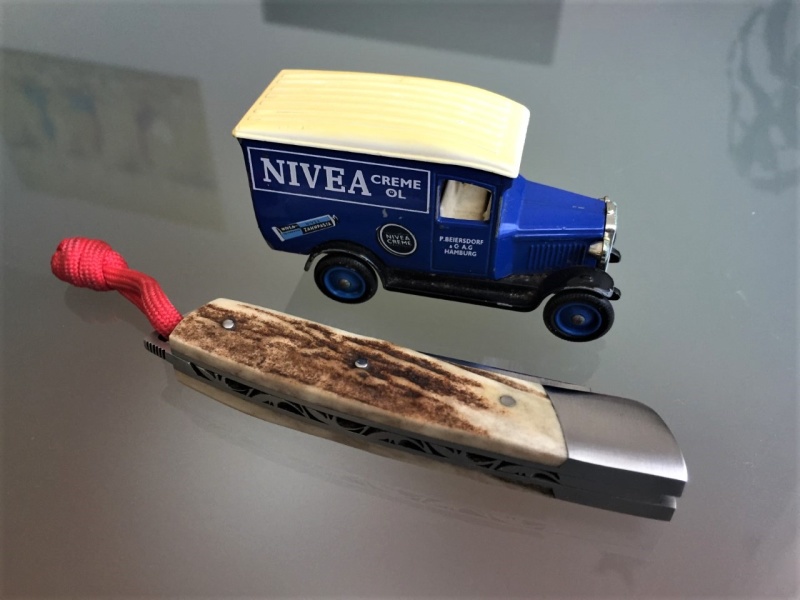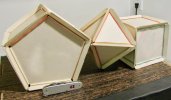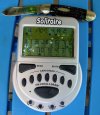-
The BladeForums.com 2024 Traditional Knife is available! Price is $250 ea (shipped within CONUS).
Order here: https://www.bladeforums.com/help/2024-traditional/
You are using an out of date browser. It may not display this or other websites correctly.
You should upgrade or use an alternative browser.
You should upgrade or use an alternative browser.
Traditional Knives and Toys
- Thread starter Just Tom.
- Start date
- Joined
- Jan 9, 2021
- Messages
- 418
- Joined
- May 14, 2018
- Messages
- 28,969
While I agree with you, it's much harder to find Original Series stuff.Kirk is the only Captain that matters, John.
5K Qs
Gold Member
- Joined
- Jul 20, 2014
- Messages
- 15,819
- Joined
- May 14, 2018
- Messages
- 28,969
Thank you, GT.Very authoritative Picard bust, John!
I figured you'd appreciate it.
r8shell
Knifemaker / Craftsman / Service Provider
- Joined
- Jan 16, 2010
- Messages
- 25,902
Did you make those? My brother makes some similar forms out of plastic straws. (He enjoys studying topology as a hobby.)Very authoritative Picard bust, John!
Sometimes I like to play with models of polyhedra: prisms, pyramids, dipyramids, and especially Platonic solids.
View attachment 1606017
- GT
5K Qs
Gold Member
- Joined
- Jul 20, 2014
- Messages
- 15,819
I have a "bank box" containing at least a dozen different polyhedron models, some of which I inherited from the guy I was hired to replace, and some of which I made myself using plastic templates I inherited from him. I've replaced the rubber bands on almost all of them over the years, and I've occasionally replaced worn-out faces. I like those models because they're big enough for students in a "normal" classroom to see as I try to demonstrate some concept or procedure we're exploring. The plastic templates are essential, making it easy to cut out as many regular 3-gons, 4-gons, and 5-gons as I need with the appropriate notches in them; I usually use old file folders as the material from which I build my models. I usually give my students paper patterns (easily found on the Web) they can use to build their own models of the 5 regular polyhedra.Did you make those? My brother makes some similar forms out of plastic straws. (He enjoys studying topology as a hobby.)
There are lots of other ways to build them. I like the straws-and-pipecleaners models that it sounds like your brother makes to get a "wire-frame" effect. There are also lots of commercial materials available. I once ordered, for my department, a bunch of commercial Polydrons that are essentially plastic polygons with various numbers of sides that "snap together" to build 3-D shapes.
- GT
5K Qs
Gold Member
- Joined
- Jul 20, 2014
- Messages
- 15,819
Not only do I like to play with geometric shapes (post #608), but also I like to play with numbers. One way to do that is with the game Rummikub, of which a game in progress is shown below with a Case Peanut.
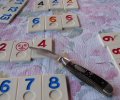
And speaking of Peanuts, what member of the Cult of the Peanut doesn't like to play with dry-roasted, unsalted peanuts laid out in a numeric array?? (12 rows of 7 peanut halves is 84 peanut halves, and if you rotate 90 degrees, you see that 7 rows of 12 peanut halves is also 84 peanut halves. Generalizing our play, we conjecture that 12x7 = 7x12 = 84. Perhaps playing for peanuts will even lead us to conjecture that a x b = b x a. Go Fish!!)
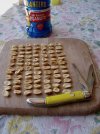
- GT

And speaking of Peanuts, what member of the Cult of the Peanut doesn't like to play with dry-roasted, unsalted peanuts laid out in a numeric array?? (12 rows of 7 peanut halves is 84 peanut halves, and if you rotate 90 degrees, you see that 7 rows of 12 peanut halves is also 84 peanut halves. Generalizing our play, we conjecture that 12x7 = 7x12 = 84. Perhaps playing for peanuts will even lead us to conjecture that a x b = b x a. Go Fish!!)

- GT
r8shell
Knifemaker / Craftsman / Service Provider
- Joined
- Jan 16, 2010
- Messages
- 25,902
But...but...then why doesn't aGeneralizing our play, we conjecture that 12x7 = 7x12 = 84. Perhaps playing for peanuts will even lead us to conjecture that a x b = b x a. Go Fish!!)
5K Qs
Gold Member
- Joined
- Jul 20, 2014
- Messages
- 15,819
But...but...then why doesn't ab = b
a ?

Let's think peanuts again.
If you and I wanted to equally share a pile of 6 dry-roasted unsalted peanut halves, we'd each get 3 peanut halves: 6÷2 = 3.
But if there were 6 of us who wanted to equally share 2 peanut halves, we're obviously not going to each get 3 of them! 2÷6 ≠ 3
In fact, this opens up the whole wonderful world of fractions to us!!
And isn't life much sweeter from the diversity of mathematical operations? Isn't it WAY more interesting that some operations are commutative (e.g., + and x) and some are not (e.g., – and ÷)?
(And then there are the intriguing exceptions, like a – b = b – a and a÷b = b÷a only if a = b, and in the latter case, neither a nor b is 0!!)
(My alternate answer comes from Bob Dylan:
It ain't no use to sit and wonder why, babe,
If'n you don't know by now.
And it ain't no use to sit and wonder why, babe,
It don't matter anyhow.)
- GT
- Joined
- Jan 9, 2021
- Messages
- 418
The answer, my friend, is blowing in the wind.
Let's think peanuts again.
If you and I wanted to equally share a pile of 6 dry-roasted unsalted peanut halves, we'd each get 3 peanut halves: 6÷2 = 3.
But if there were 6 of us who wanted to equally share 2 peanut halves, we're obviously not going to each get 3 of them! 2÷6 ≠ 3
In fact, this opens up the whole wonderful world of fractions to us!!
And isn't life much sweeter from the diversity of mathematical operations? Isn't it WAY more interesting that some operations are commutative (e.g., + and x) and some are not (e.g., – and ÷)?
(And then there are the intriguing exceptions, like a – b = b – a and a÷b = b÷a only if a = b, and in the latter case, neither a nor b is 0!!)
(My alternate answer comes from Bob Dylan:
It ain't no use to sit and wonder why, babe,
If'n you don't know by now.
And it ain't no use to sit and wonder why, babe,
It don't matter anyhow.)
- GT
5K Qs
Gold Member
- Joined
- Jul 20, 2014
- Messages
- 15,819
5K Qs
Gold Member
- Joined
- Jul 20, 2014
- Messages
- 15,819
My wife has been working this summer on converting a large section of our basement into a sewing area. Over the years, the basement had gradually become primarily a storage area, so I've been trying to help her organize and/or discard a lot of the stuff that accumulated down there, including lots of old toys, puzzles, and games. Here's a game I recently unearthed on a basement shelf:

- GT

- GT
wouter1967
Gold Member
- Joined
- Jul 25, 2009
- Messages
- 768
Both the knife aswel as 'Animal' are from the 2nd half of the 1970's.

Animal_The_Drummer by Wouter | Sere, on Flickr

Animal_The_Drummer by Wouter | Sere, on Flickr
5K Qs
Gold Member
- Joined
- Jul 20, 2014
- Messages
- 15,819
Todd
 bigfish64
and his family visited Michigan recently, and Todd carried a Vic Classic SD with a picture of a lighthouse on it because Michigan has many lighthouses. That reminded me that my family has a jigsaw puzzle of The Lighthouses of the Great Lakes. Here's a photo of the box cover showing what the finished puzzle should look like, along with a closer shot to show what some of the lighthouse sketches look like on the puzzle.
bigfish64
and his family visited Michigan recently, and Todd carried a Vic Classic SD with a picture of a lighthouse on it because Michigan has many lighthouses. That reminded me that my family has a jigsaw puzzle of The Lighthouses of the Great Lakes. Here's a photo of the box cover showing what the finished puzzle should look like, along with a closer shot to show what some of the lighthouse sketches look like on the puzzle.


- GT


- GT





